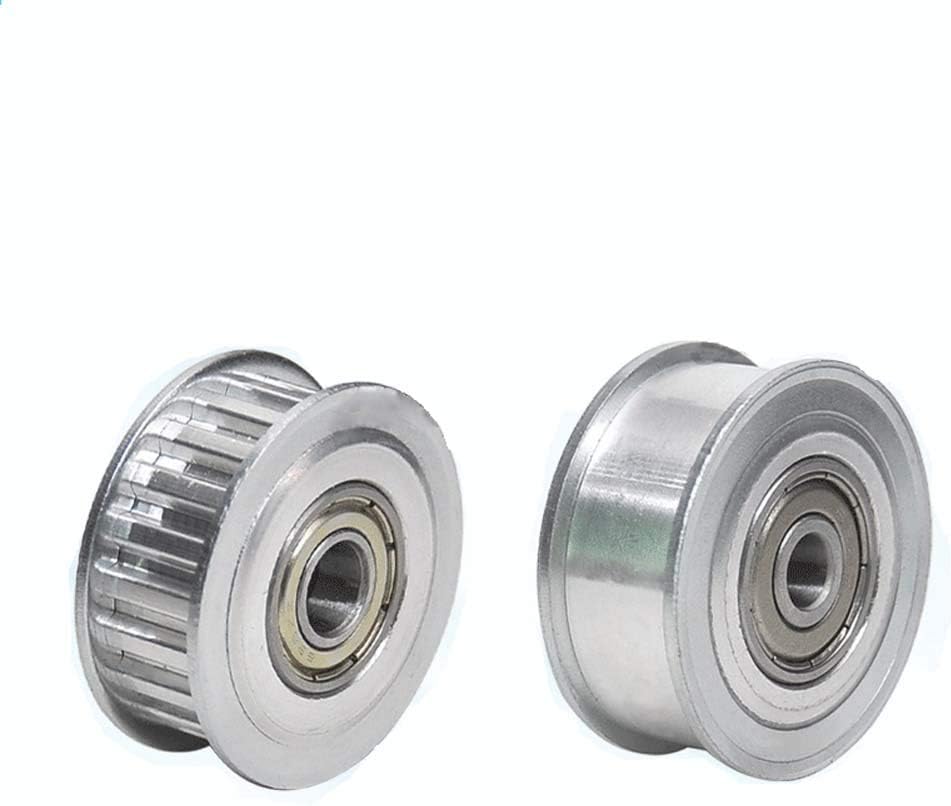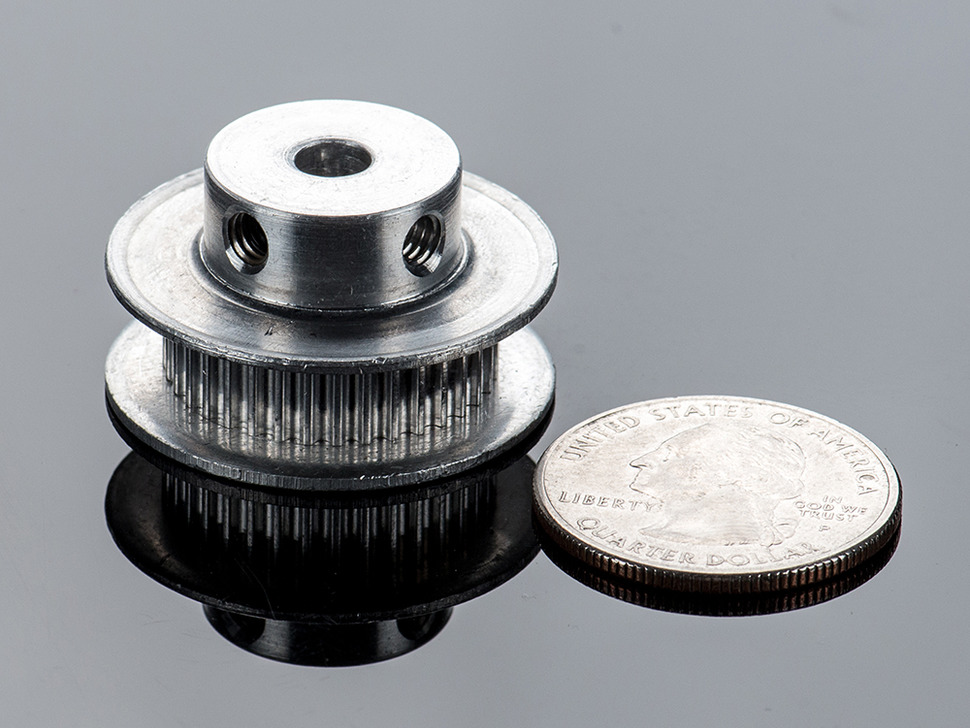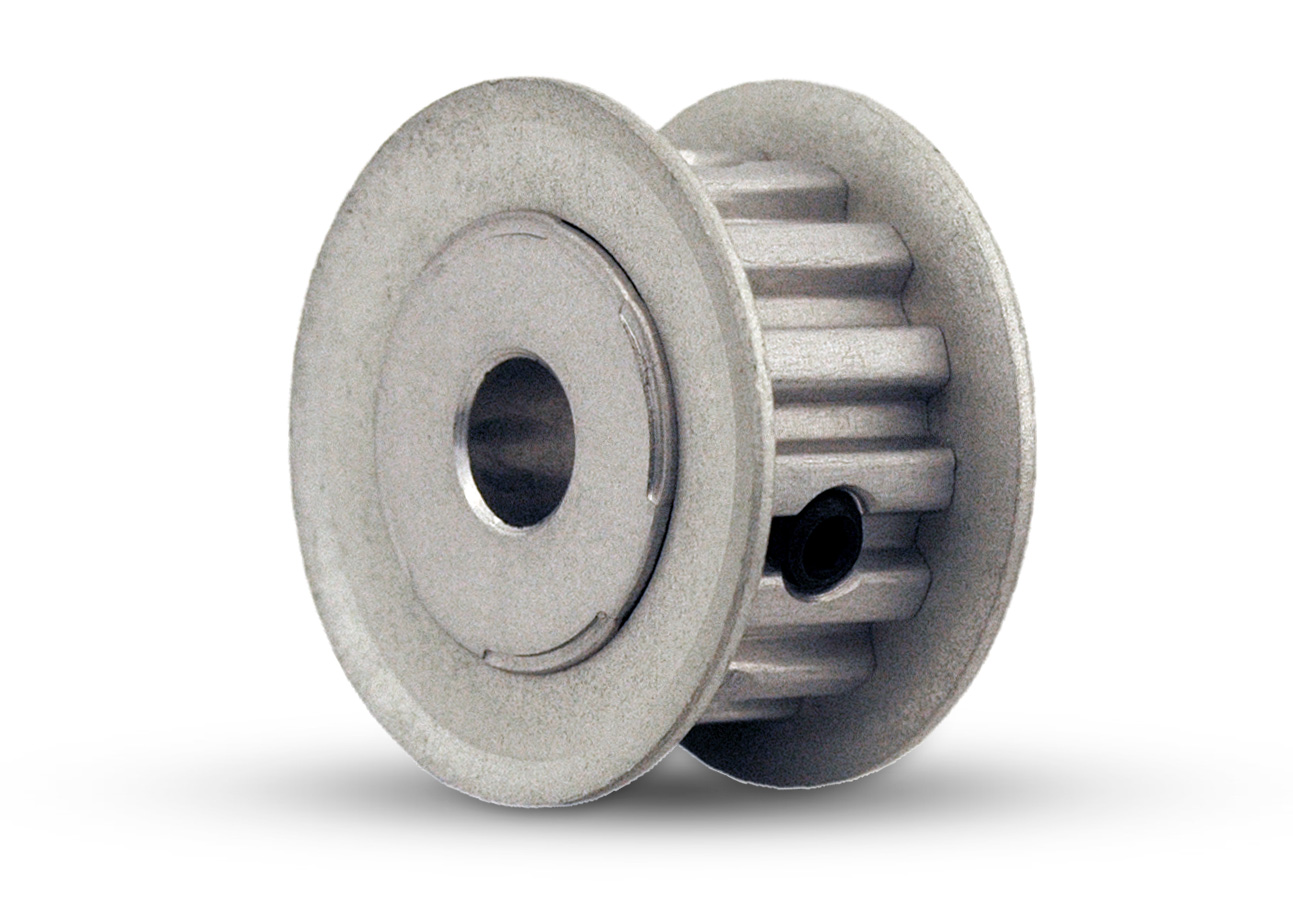Product Description
Product Description
Aluminum/C45 Timing Belt Pulley
| Product Name | Aluminium Timing Pulley MXL XL L H XH XXH T2.5 T5 T10 AT5 AT10 S2M S3M S5M S8M GT2 GT3 GT5 3M 5M 8M Tooth timing Belt Pulley | |
| Teeth profile | Trapezoidal toothed | MXL, XXL, XL, L, H, XH, XXH |
| T-toothed | T2.5, T5, T10, T20 | |
| Arc toothed | HTD3M, HTD5M, HTD8M, HTD14M, HTD20M, Gt2, Gt3, Gt5 | |
| S-toothed | S2M, S3M, S4.5M, S5M, S8M, S14M | |
| Parabolic-toothed | P2M, P3M, P5M, P8M, P14M | |
| Y-toothed | G2M, G3M, G5M, Y8M | |
| Teeth Quantity | 10-150 teeth or customized | |
| Inner Bore | 2-200mm H7 precision or customized | |
| Belt width | 4mm, 6mm, 9mm, 10mm, 12mm, 15mm, 20mm, 25mm, 30mm, 40mm, 50mm, 1/4”, 5/16”, 3/8”, 1/2”, 3/4”, 1”, 1.5”, 2”or customized | |
| Material | carbon steel C45, Aluminum 6061, 6082 | |
| Surface treatment | Anodize,Black Oxide,Phosphate, Galvanization, Nitriding, Dichromate | |
Detailed Photos
Timing pulley used on conveyor roller
Workshop
Equipments:
Lathe machine, Hobbing machine,Drilling machine,CNC machine,Milling machine, etc
FAQ
Q1: Are you trading company or manufacturer ?
A: We are factory.
Q2: How long is your delivery time and shipment?
1.Sample Lead-times: 10-20 days.
2.Production Lead-times: 30-45 days after order confirmed.
Q3: What is your advantages?
1. The most competitive price and good quality.
2. Perfect technical engineers give you the best support.
3. OEM is available.
| Certification: | ISO |
|---|---|
| Pulley Sizes: | Timing Belt Pulley |
| Manufacturing Process: | Hobbing Teeth |
| Material: | Aluminum |
| Surface Treatment: | Anodizing |
| Application: | Chemical Industry, Grain Transport, Mining Transport, Power Plant |
| Customization: |
Available
| Customized Request |
|---|

Can XL pulleys be integrated into existing mechanical systems for upgrades?
Yes, XL pulleys can be integrated into existing mechanical systems for upgrades. Here is a detailed explanation of the integration process and the benefits of upgrading with XL pulleys:
1. Compatibility:
XL pulleys are designed to be compatible with standard timing belts, making them suitable for integration into existing systems that utilize timing belt drives. The pulleys are available in various sizes and tooth profiles, allowing for easy replacement and compatibility with different belt lengths and widths.
2. Improved Performance:
Integrating XL pulleys into an existing mechanical system can lead to improved performance. XL pulleys offer advantages such as higher torque capacity, increased speed capabilities, and better power transmission efficiency compared to smaller pulley sizes. Upgrading to XL pulleys can enhance the system’s overall performance, allowing for higher loads, faster speeds, and improved efficiency.
3. Enhanced System Precision:
XL pulleys are known for their precise tooth profiles and accurate dimensional control. By integrating XL pulleys, the system can benefit from improved positional accuracy and reduced backlash. This is particularly important in applications where precise positioning or synchronization is crucial, such as CNC machines, robotics, or high-precision conveyors.
4. Customization Options:
XL pulleys offer customization options, allowing them to be tailored to specific system requirements. Manufacturers can modify pulley dimensions, bore sizes, keyway configurations, or tooth profiles to match the existing system’s needs. This customization capability ensures a seamless integration into the system without the need for significant modifications or adaptations.
5. Cost-Effective Upgrade:
Integrating XL pulleys into an existing mechanical system can be a cost-effective upgrade option. Since the system’s core components, such as the shafts and bearings, remain unchanged, the upgrade primarily involves replacing the existing pulleys with XL pulleys. This reduces the cost and complexity associated with a complete system overhaul while still providing significant performance improvements.
6. Ease of Installation:
The integration of XL pulleys into existing systems is relatively straightforward. The process typically involves removing the old pulleys and replacing them with the new XL pulleys. As long as the pulley dimensions and tooth profiles are compatible, installation can be completed with basic tools and minimal downtime.
7. System Scalability:
XL pulleys offer scalability options, allowing for future system expansions or modifications. If the mechanical system requires capacity upgrades or changes in operating conditions, integrating XL pulleys provides flexibility for system scalability. Additional pulleys can be easily added or replaced to accommodate the evolving needs of the system.
In summary, XL pulleys can be successfully integrated into existing mechanical systems for upgrades. The compatibility, improved performance, enhanced precision, customization options, cost-effectiveness, ease of installation, and system scalability make XL pulleys a viable choice for upgrading mechanical systems to achieve better performance, efficiency, and adaptability.

How do advancements in material technology influence the design of modern XL pulleys?
Advancements in material technology have a significant impact on the design of modern XL pulleys. Here’s a detailed explanation of how these advancements influence their design:
1. Enhanced Durability:
New materials with improved strength and durability allow for the design of XL pulleys that can withstand higher loads, operate at higher speeds, and have increased resistance to wear and fatigue. Advanced materials, such as high-strength alloys, composites, or specialized polymers, provide superior mechanical properties, enabling the design of more robust and long-lasting pulleys.
2. Weight Reduction:
Lightweight materials, such as carbon fiber composites or engineered polymers, contribute to the design of lightweight XL pulleys. Reduced weight in pulley systems offers advantages such as improved energy efficiency, reduced inertia, and lower overall system weight. This is particularly beneficial in applications where weight reduction is critical, such as aerospace, automotive, or portable machinery.
3. Corrosion Resistance:
New materials with excellent corrosion resistance properties, such as stainless steel or corrosion-resistant coatings, enable the design of XL pulleys suitable for harsh or corrosive environments. Corrosion-resistant pulleys are essential in industries such as marine, chemical processing, or outdoor applications where exposure to moisture, chemicals, or saltwater can cause degradation and premature failure.
4. Temperature Resistance:
Advancements in material technology have led to the development of materials that can withstand extreme temperatures. For applications involving high or low temperature environments, such as industrial ovens, furnaces, or cryogenic systems, the use of materials with superior temperature resistance ensures the pulleys maintain their performance and integrity under challenging operating conditions.
5. Noise and Vibration Damping:
New materials with inherent damping properties, such as elastomers or composite laminates, contribute to the design of XL pulleys that can effectively reduce noise and vibrations during operation. This is particularly important in applications that require low noise levels or where excessive vibrations can affect the performance and reliability of the system.
6. Customization and Flexibility:
Advancements in material technology provide designers with a wider range of options to tailor the properties of XL pulleys to specific application requirements. Materials can be formulated or engineered to meet specific needs such as high friction coefficients, electrical conductivity, or resistance to specific chemicals. This customization and flexibility in material selection allow for the optimization of pulley design and performance for various applications.
Overall, advancements in material technology have revolutionized the design of modern XL pulleys by offering improved durability, reduced weight, corrosion resistance, temperature resistance, noise and vibration damping, and customization options. Manufacturers can leverage these advancements to develop pulleys that meet the evolving needs of diverse industries and deliver enhanced performance and reliability.

In which applications and industries are XL pulleys commonly used?
XL pulleys find extensive use in various applications and industries that require precise motion control and power transmission. Here are some common applications and industries where XL pulleys are commonly employed:
1. Robotics:
XL pulleys are utilized in robotic systems for precise positioning and movement control of robot arms, grippers, and other robotic components. They enable accurate and synchronized motion, allowing robots to perform complex tasks with precision.
2. CNC Machines:
CNC (Computer Numerical Control) machines, such as milling machines and lathes, rely on XL pulleys for precise control of spindle speed and tool positioning. The accurate motion provided by XL pulleys ensures high-quality machining and dimensional accuracy in CNC operations.
3. 3D Printers:
XL pulleys are commonly used in 3D printers to control the movement of the print head and the positioning of the build platform. The precise motion control facilitated by XL pulleys contributes to the accuracy and fine detail of the printed objects.
4. Automated Systems:
XL pulleys are employed in various automated systems, including conveyor systems, packaging machinery, assembly lines, and material handling equipment. These systems require synchronized and precise motion to ensure efficient and accurate operation.
5. Industrial Machinery:
In industrial settings, XL pulleys are used in a wide range of machinery, such as textile machines, printing presses, woodworking equipment, and industrial automation systems. They provide reliable power transmission and motion control in these demanding applications.
6. Automotive Industry:
XL pulleys are utilized in automotive applications, including engine timing systems, accessory drives, and power steering systems. The precise control and synchronization offered by XL pulleys contribute to efficient and reliable operation of these automotive components.
7. Medical Devices:
In the medical field, XL pulleys are found in equipment such as diagnostic machines, laboratory automation systems, and surgical instruments. They enable accurate movement and positioning, ensuring the precision required for medical procedures and diagnostics.
8. Aerospace and Defense:
XL pulleys are used in aerospace and defense applications, such as satellite positioning systems, guidance systems, and unmanned aerial vehicles (UAVs). The reliable motion control provided by XL pulleys is crucial for the accurate operation of these aerospace and defense systems.
9. Research and Development:
In research and development laboratories, XL pulleys are employed in experimental setups, prototyping systems, and testing equipment. Their precise motion control capabilities support the development and validation of new technologies and products.
In summary, XL pulleys are commonly used in applications and industries that require precise motion control and power transmission. Their versatility and reliability make them suitable for a wide range of applications, from robotics and CNC machines to 3D printers, automated systems, automotive components, medical devices, aerospace, and research and development.


editor by CX
2023-11-14
